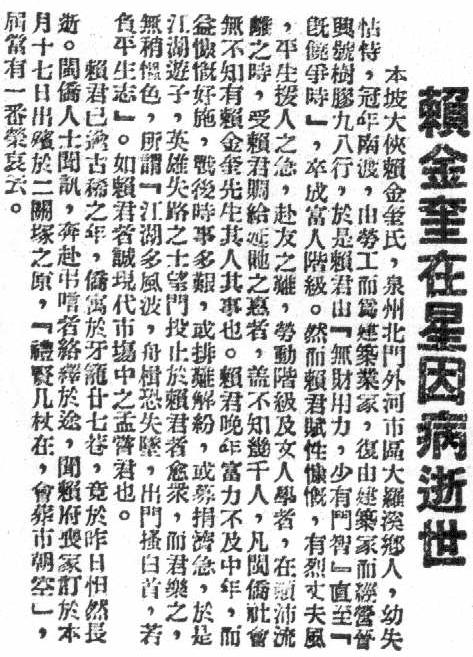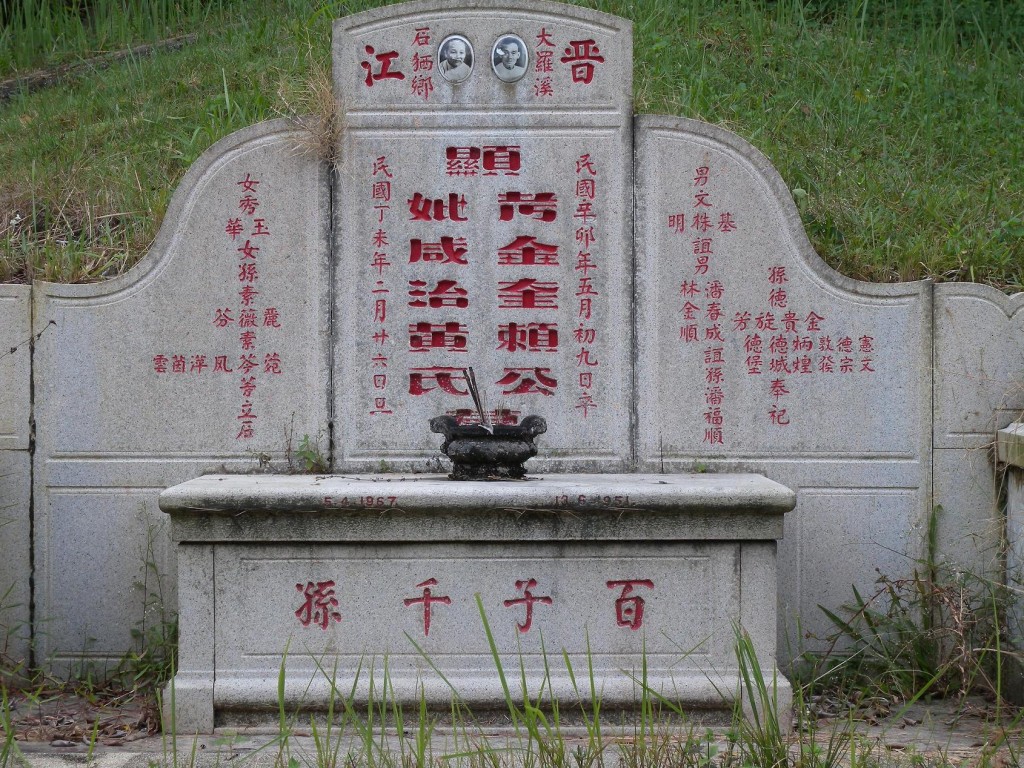Luah Kim Kway, The Chivalrous
1Luah Kim Kway (赖金奎) the Chivalrous
by Ang Yik Han
On first impression, his is a typical story of a poor migrant made good. Orphaned when young, Luah Kim Kway left for the Nanyang at the age of 19 to seek his fortune. Like other uneducated migrants who toiled unceasingly, he was at various times a coolie, a hawker and a miner before hitting his first pot of gold as a building contractor. Subsequently, he branched out into the rubber and import/export businesses. As a community leader, he was one of the founders of the Chin Kang Association, a locality association catering to Hokkiens from Chin Kang (晋江 – “Jin Jiang” in pinyin) county in Fujian province. He served as the association’s vice chairman for many years and was actively involved in its mutual aid group and school.
Many also knew Mr Luah, or Kway Pek (“Uncle Kway” in Hokkien) as he was respectfully called, as a powerful secret society headman.
A coolie newly arrived in Singapore found himself amongst strangers in a strange land. Very often, there was no one he could trust and turn to for support other than clansmen or associates from his home village. Thus was born the “coolie keng” or coolie quarters which provided shelter, occupational support and fellowship for coolies sharing a common origin. In return for a small sum every month, the coolie had a space where he could sleep and stow the trunk containing his meagre belongings.
Due to the nature of migrant society then, differences were often settled by force of arms and numbers counted. Members of coolie kengs banded together for self protection and over time coolie kengs became synonymous with secret societies. There were frequent clashes amongst rival coolie kengs over turf issues. Some of them even evolved into criminal organisations which were a constant headache to the colonial authorities.
Many of the Chin Kang Hokkiens who arrived in Singapore in the early days worked as lightermen and dock labourers, traditional occupations as their homeland was by the sea. Like coolies from other regions, they were organised along the lines of the coolie kengs they belonged to. According to the Chin Kang Association’s records, at one point there were more than sixty coolie kengs in town set up by Hokkiens from Chin Kang. In areas like Bali Lane, there were Chin Kang enclaves due to the presence of numerous coolie kengs.
The Puah Kor (Hokkien for八股 or “8 formations”) was a confederation of societies largely made up of Chin Kang coolie kengs with a sprinkling of non-Chin Kang groups. Unlike other secret societies which were involved in activities of a criminal nature, the Puah Kor was known for its tight discipline. It did not actively seek conflicts with other groups and acted only to protect its members’ interests. Mr Luah was the leader of the Puah Kor, a position which must have reinforced his ability to arbitrate in conflicts between Chin Kang coolie kengs as well as within the larger Chinese community in his other role as a representative of the Chin Kang Association.
An anecdote demonstrates the extent of his influence. After the war, a Chinese basketball team from Manila composed largely of Chin Kang Hokkiens was in Singapore on a fund raising campaign. For some reason, some factions took a dislike to the team’s captain and there were rumours floating that the coming matches would be violently disrupted. One of the worried organisers took the matter to Mr Luah. Mr Luah only commented in his quiet manner, “Shall we have some fried bee hoon?” During the meal, the conversation ranged far and wide with many things discussed but not the subject of the visit. As the guest was about to take his leave, Mr Luah told him, “Give me sixty tickets for tonight’s game.” That night, two hundred stout men turned up for the game at Gay World which proceeded peacefully. The following evenings were without incident as well.
For obvious reasons, it is almost impossible to obtain documented accounts of secret society personalities. Mr Luah was an exception. His contributions and high regard in society were acknowledged in an obituary published in the Nanyang Siang Pau when he passed away in 1951. It described him as a principled man whom others trusted and mentioned his generosity to those in need. As an epitaph, a phrase used by the paper, “a chivalrous man” (大侠) would be most fitting.
Mr Luah’s final resting place is by the side of the road in Hill 3, a short distance from Tan Chor Lam’s grave.
References:
- 新加坡晋江会馆纪念特刊(1918-1978)[Commemorative Publication, 1918-1978]
- 新加坡晋江会馆庆祝成立80周年暨互助部成立52周年纪念特刊 [80th Anniversary and Mutual-Aid Section’s 52nd Anniversary Souvenir Magazine]
- Interview with Ho Bee Swee, Collection of Oral History Recording Database





Comments
Trackbacks
Check out what others are saying about this post.[…] about the life of this exceptional gentleman, Luah Kim Kway, in the Bukit Brown blog here. Tweet(function() { var po = document.createElement('script'); po.type = 'text/javascript'; […]